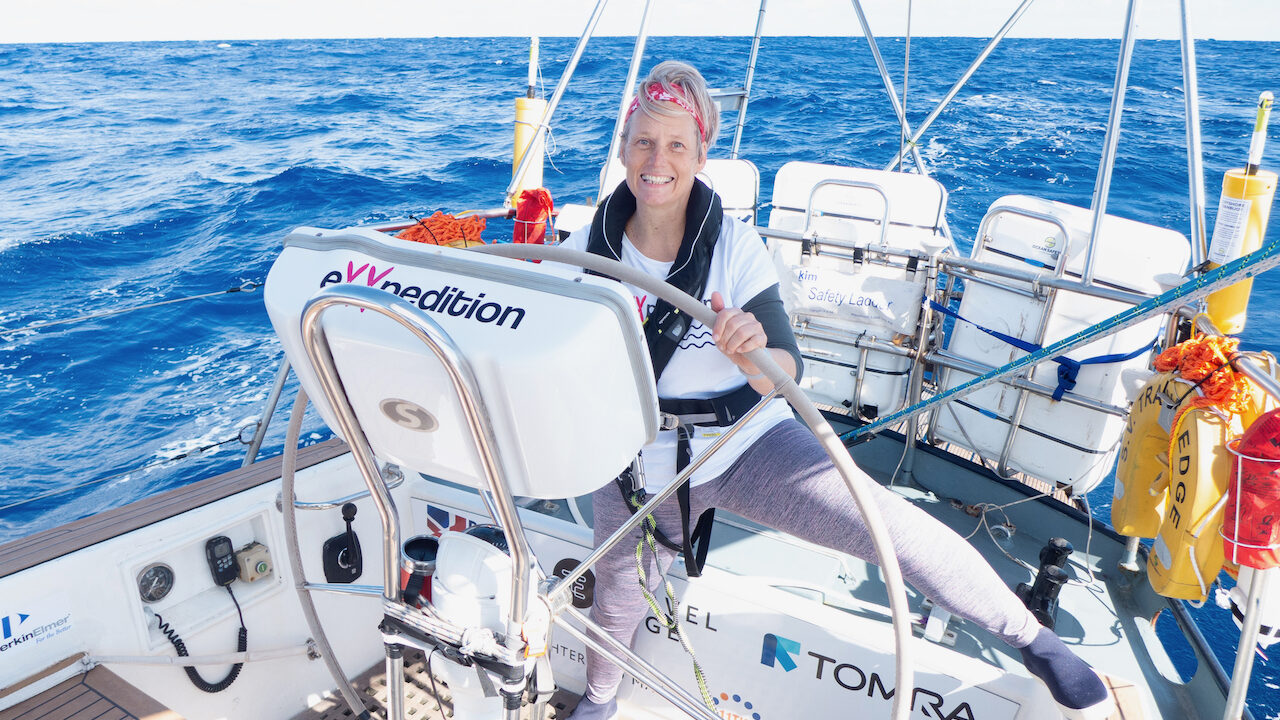eXXpedition Round-the-World 2019-21. 300 Women. 38,000 Nautical Miles. 1 Mission.
Thrilled beyond imagination, I had been selected as a crew member of the all-female sailing voyage and research mission eXXpedition. The goal is to investigate the causes of and science-based solutions to ocean plastic pollution. I sailed on the inaugural Leg 1 from Plymouth, UK to the Azores in early October 2019.
Award winning oceans advocate and skipper Emily Penn is leading the eXXpedition of 300 women on a challenging voyage of over 38,000 nautical miles and 30 voyage legs for two-years around the world, which is currently underway.
eXXpedition is pronounced ex-expedition. The double ‘X’ symbolizes the female chromosome in an effort to call attention to the impact of endocrine (hormone) disrupting chemicals (EDC) from plastics on human health, especially on female reproduction.
Sampling ocean water for plastic particles
Katrin-Scholz-Barth getting ready for the cruise
Setting sail
Crew
On a daily basis and repeatedly through diet, drinking water and indoor air, we expose ourselves to a mixture of multiple chemicals that are known EDCs like Bisphenol-A, phthalates, and similar chemicals. Plastic bags, food packaging and containers, many household products and consumer goods like electronics, cosmetics, soaps, nail polish, as well as toys and furniture contain these endocrine disrupting chemicals. It is hard to escape; they are everywhere and often come as single-use plastics. The chemical Bisphenol-A, for instance, mimics the female hormone estrogen, which can lead to developmental disruptions, including hormone-associated cancers of the breast, ovary, and prostate.
Due to the pervasiveness of plastic products, most of the human population is constantly exposed to the chemical components of plastics. 95% of adults in the United States have had detectable levels of BPA in their urine. Exposure to chemicals such as BPA have been correlated with disruptions in fertility, reproduction, sexual maturation and other health effects.
Source: https://www.ncbi.nlm.nih.gov/pmc/articles/PMC2873021/
Ocean plastic pollution has reached a new level of awareness over the past few years as a result of research uncovered that plastics have entered our food chain. Visionary, ambitious advocates and entrepreneurs are uniting to find solutions to the problem with new products like shoes, yoga mats, sunglasses, apparel and jewelry made from recycled ocean plastics. In 2019 HP released its new Elite Dragonfly laptop, marketed as the world’s first-ever PC made with ocean-bound plastics.
In spite of all these efforts, the amount of single-use plastics in daily circulation is mind-boggling. We have work to do!
Almost 10,000 women from around the world had applied since the plans for the mission were announced in 2018. I was ecstatic, nervous and scared all at once to be onboard and contribute to this endeavor, joining the research mission and adventure. No previous sailing experience were required, so I felt ‘safe’ and was envisioning to do research, cook, clean, and whatever else might be needed. Clearly, I had no idea what was awaiting me.
Onboard the 73ft sailing vessel and research lab S.V. TravelEdge, home for the 300 women around-the-world, eXXpedition will sail through some of the most important and diverse marine environments on the planet and the Arctic, crossing four of the five oceanic gyres, which have been recorded as the densest ocean plastic accumulation zones on the planet. The research mission aims to study plastic pollution and micro plastics and tackle the devastating environmental and health impacts of single-use plastic and toxins in the world’s oceans.
Each Leg’s crew consists of 14 women: four professional sailors and a guest crew of 10 women, an international multidisciplinary group. Skipper Anna, First Mate Maggie and Deckhand Sophie managed all boat-related matters and food supplies, while mission leader Emily directed the guest crew of scientists, artists, filmmakers, teachers, doctors, and sustainability experts. We were carefully chosen to tell and document the stories as we sailed, collected, analyzed, and researched samples to ultimately fight ocean plastics.
The guest crews are divided into three watch teams who are on shift around the clock, on a 4 hours on and 8 hours off schedule. Being on shift meant the watch team performed all duties from sailing to meal preparation, cleaning and conducting science workshops.
On Leg 1, we set sail in Plymouth, UK toward Sao Miguel, Azores, Portugal. We had successfully dodged Hurricane Lorenzo coming on an unusual path eastward across the Atlantic and then heading northeast from the Azores to the UK, the opposite direction of our anticipated sailing route. Undeterred, we crossed the English Channel in unforgiving weather conditions, an already notoriously challenging part of the sea. Immediately, nine out of 14 crew members got instantly seasick. Being seasick or not, there was no excuse, all duties had to be performed, night and day. We sailed through storm after storm and experienced life at 45 degrees as we tacked the boat to move forward. It was relentless. I was so far out of my comfort zone, I willingly took instructions and followed orders, a first.
How much plastic is in the ocean?
According to some oceanic models there was an estimated 5.25 trillion particles of floating micro plastics in the ocean, weighing about 270,000 tons.
However, a recent study by SCRIPPS Institution for Oceanography published in December 2019 suggests that there is a million times more plastic in the oceans than previously thought. It is estimated that there are 8.3 Million mini-micro plastic pieces per cubic meter of water. Researchers found these mini-microplastics (<10 Microgram, smaller than the width of a human hair) in the stomachs and guts of filter feeding marine organisms like salps that travel up the ocean food chain.
As we ingest these mini-microplastics with our seafood, they enter our bloodstream and the chemical components of the plastics accumulate in our bodies where they disrupt hormonal balance.
Science onboard eXXpedition
On Leg 1 we needed to wait for calm-enough weather conditions to conduct science, which included surface water samples using the manta trawl to identify various polymer types of plastics present in the ocean, using Infrared Spectroscopy. We found microplastics in every sample, 700 miles off-shore, a scary realization.
Microbial analysis helps to study the bacteria and viruses colonizing microplastics to help identify the origins of plastics as the communities differ between the Atlantic and Pacific Oceans and with distance from shore.
The aim throughout the round-the-world voyage is to answer three science questions:
How does the quantity of microplastics compare between the world’s oceans?
What types of plastics are present?
How do ocean currents affect the distribution?
During our workshops on board we also discussed disposal and waste management solutions as ways to close the knowledge gap between plastic origins and taking required actions to close the waste loop on land. The accumulation of in the environment is avoidable, when we challenge existing perceptions, educate about microplastics and search for solutions upstream, on land, finding alternative materials and designs.
Beyond Science
Beyond contributing to cutting-edge scientific research, the mission aims to celebrate women in STEM, exploration and sailing while creating a powerful global network of Ambassadors. Now back on dry land, the real works starts as we share our pictures, stories and first-hand experience at sea to help end the flow of plastics into our oceans and empower everyone to act and have meaningful impact through personal actions and responsible choices.
eXXpedition Round the World aims to:
Support solutions science by contributing to world class scientific studies that are urgently needed to inform up-stream solutions and close-the-loop on plastic waste on land; partnering with internationally recognized ocean plastic experts at University of the Plymouth and the University of Georgia.
Challenge perceptions by using our platform to inform and educate so that people can better understand the real problem of micro-plastics and use that to shape actions and solutions
Create a community of change-makers, STEM role models and inspiring global ambassadors.
Personal Actions
What can EVERYONE DO? Demand alternative materials. Stop the mindless use of plastics, especially single-use plastic. Choose food and products without plastics. Wash less – micro plastics from nylon and polyester clothes end up in our oceans as mini-microplastics!
To all women warriors out there: If you wish to be part of this mission yourself, check it out and apply for subsequent phases of the 2-year voyage that lasts until September 2021! Or to follow the live journey and learn more detailed information about the crew of amazing women and partners, please visit https://exxpedition.com
About the author: Katrin Scholz-Barth is an internationally recognized sustainability practitioner based in Doha, Qatar. She chairs SustainableQATAR.com a think and do tank and is the Principal at Katrin Scholz-Barth Consulting. As part of the 2022 FIFA World Cup Qatar program she helped define and create the program-wide sustainability and innovation strategies to deliver a carbon-neutral mega sports event in a fragile desert environment.
Katrin teaches strategic sustainability and decarbonization to young entrepreneur and startup CEOs, addressing the correlation between diligent value-based business practices and financial performance, green funding and long-term investment potential based on environmental social governance (ESG), responsibility, resilience and regenerative growth and development.
Sources:
Early pregnancy exposure to endocrine disrupting chemical mixtures are associated with inflammatory changes in maternal and neonatal circulation
https://www.nature.com/articles/s41598-019-41134-z
Plastics, the environment and human health: current consensus and future trends
https://www.ncbi.nlm.nih.gov/pmc/articles/PMC2873021/
Bisphenol A (BPA)
https://www.niehs.nih.gov/health/topics/agents/sya-bpa/index.cfm
Microplastics a million times more abundant in the ocean than previously thought


